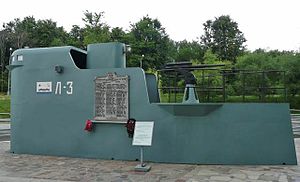
| |
| History | |
|---|---|
| Name | L-3 Фрунзенец (Frunzenets) |
| Launched | 8 August 1931 |
| Decommissioned | 15 February 1971 |
| Fate | Broken up, with conning tower preserved as a memorial |
| General characteristics | |
| Displacement |
|
| Length | 81 m (265 ft 9 in) |
| Beam | 7.5 m (24 ft 7 in) |
| Draft | 4.08 m (13 ft 5 in) |
| Propulsion |
|
| Speed |
|
| Range |
|
| Complement | 53 |
| Armament |
|
| Service record | |
| Part of: | Baltic Fleet |
| Commanders: | Vladimir Konovalov (1943–1945) |
| Victories: | German transport ship Goya (1945) |
The World War II Soviet submarine L-3 belonged to the L-class or Leninets class of minelayer submarines. It had been named Bolshevik and later Frunzenets, before it was decided that submarines should stop having names and carry numbers instead.
Under Captain of the 3rd Rank Vladimir Konovalov, L-3 was one of the most successful Soviet submarines of World War II. On 16 April 1945, it sank the German refugee transport MV Goya, an event that (if calculated by loss of life) is deemed to be one of the worst marine disasters ever, when 6,000 to 7,000 people died in the icy waters of the Baltic Sea.
After the dismantling of the submarine, part of it was used as the monument in Liepāja, though the monument was relocated to Moscow in 1995. Today, the conning tower of L-3 is on display in Moscow as a monument in Park Pobedy ("Victory Park") at Poklonnaya Gora museum.
| Date | Ship | Flag | Tonnage | Notes |
|---|---|---|---|---|
| 1 October 1941 | Kaija | 1876 GRT | freighter (mine) | |
| 19 November 1941 | Henny | 764 GRT | freighter (mine) | |
| 22 November 1941 | Uno | 430 GRT | tanker (mine-unconfirmed) | |
| 26 November 1941 | Engerau | 1142 GRT | freighter (mine) | |
| 18 August 1942 | C.F. Liljevalch | 5492 GRT | freighter (torpedo) | |
| 25 August 1942 | Franz Bohmke | 210 GRT | freighter (mine) | |
| 17 November 1942 | Hindenburg | 7880 GRT | freighter (mine) | |
| 9 December 1942 | Edith Bosselmann | 952 GRT | freighter (mine) | |
| 5 February 1943 | Tristan | ? GRT | freighter (mine – probably) | |
| 5 February 1943 | Grundsee | 866 GRT | freighter (mine – probably) | |
| 30 March 1943 | U-416 | 769 GRT | submarine (mine – later recovered) | |
| 20 November 1944 | T-34 | 1294 GRT | large torpedo boat (mine) | |
| 29 January 1945 | Henry Lutgens | 1141 GRT | merchant (mine) | |
| 23 March 1945 | M-3138 | 112 GRT | auxiliary minesweeper (mine) | |
| 30 March 1945 | Jersbek | 2804 GRT | merchant (mine – possibly) | |
| 17 April 1945 | Goya | 5230 GRT | transport ship (torpedo) | |
| Total: | 30,965 GRT | |||
Mines laid by L-3 also damaged the German sailing vessel Albert Leo Schlageter (1634 GRT) and the German icebreaker Pollux (4191 GRT).
L-3 is the twelfth-highest-scoring Soviet submarine (not counting ships sunk by mines she laid), with 10,722 GRT sunk.
Trivia
In the book and subsequent film The Hunt for Red October, the fictional Soviet Alfa class nuclear-powered attack submarine is named the V.K. Konovalov.
References
- "National Submarine Fleet Encyclopedia". Retrieved 6 October 2014.
- "Poklonaya Gora state museum". Retrieved 6 October 2014.
- "L-3". Retrieved 6 October 2014.
- "L-3". Retrieved 6 October 2014.